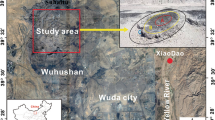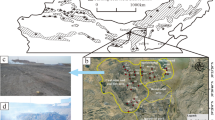Abstract
Carcinogenic and mutagenic polycyclic aromatic hydrocarbons (PAHs) generated in coal combustion have caused great environmental health concern. Seventeen PAHs (16 high priority PAHs recommended by USEPA plus Benzo[e]pyrene) present in five raw bituminous coals and released during bituminous coal combustion were studied. The effects of combustion temperature, gas atmosphere, and chlorine content of raw coal on PAHs formation were investigated. Two additives (copper and cupric oxide) were added when the coal was burned. The results indicated that significant quantities of PAHs were produced from incomplete combustion of coal pyrolysis products at high temperature, and that temperature is an important causative factor of PAHs formation. PAHs concentrations decrease with the increase of chlorine content in oxygen or in nitrogen atmosphere. Copper and cupric oxide additives can promote PAHs formation (especially the multi-ring PAHs) during coal combustion.
Similar content being viewed by others
References
Berkowitz, N., 1985. The Chemistry of Coal. Coal Science and Technology 7, Elsevier.
Bose D., Senkan M., 1983. On the combustion of chlorinated hydrocarbons I Trichloroethylene. Combust. Sci. and Tech, 35:187–292.
Feitelberg, A.S., Longwell, J.P., Sarofim, A.F., 1993. Metal enhanced soot and PAH formation. Combustion and Flame, 92:241–253.
Ledesma, E.B., Kalish, M.A., Nelson, P.F., Wornat, M.J., Mackie, J.C., 2000. Formation and fate PAH during pyrolysis and fuel-rich combustion of coal primary tar. Fuel, 79:1801–1814.
Li, X.D., Fu, G., You, X.F., Yan, J.H., 2003. Study of PAHs formation from combustion of different coal type. Journal of Engineering for Thermal Energy and Power, 18:125–127 (in Chinese).
Liu, K.L., Han, W.J., Pan, W.P., Riley, J.T., 2001. Polycyclic aromatic hydrocarbon (PAH) emission from a coal-fired pilot FBC system. Journal of Hazardous Materials, B84:175–188.
Mastral, A.M., Callen, M., 2000. A review on polycyclic aromatic hydrocarbon (PAH) emissions from energy generation. Environ. Sci. Technol., 34(15):3051–3057.
Mastral, A.M., Callen, M., Murillo, R., Garcia, T., 1998a. Assessment of PAH emission as a function of coal combustion variables in fluidised bed 2: Air excess percentage. Fuel, 77(13):1513–1516.
Mastral, A.M., Callen, M., Murillo, R., 1998b. Assessment of PAH emissions as a function of coal combustion variables. Fuel, 77(13):1533–1536.
Mastral, A.M., Callen, M., Murillo, R., Garcia T., Vinas M., 1999. Influence on PAH emissions of the air flow in AFB coal combustion. Fuel, 78:1553–1557.
Mastral, A.M., Callen, M.S., Garcia, T., 2000. Toxic organic emissions from coal combustion. Fuel Processing Technology, 67:1–10.
Mastral, A.M., Garcia, T., Callen, M.S., Lopez, J.M., Murillo, R., Navarro, M.V., 2001. Effects of limestone on polycyclic aromatic hydrocarbon emissions during coal atmospheric fluidized bed combustion. Energy & Fuels, 15:1469–1474.
Miller, J., 1994. Emissions of organic hazardous air pollutants from the combustion of pulverized coal in a small-scale combustor. Environ. Sci. Technol., 28:1150–1158.
Ni, M.J., You, X.F., Li, X.D., Yin, X.F., Cao, Z.Y., Yan, J.H., Cen, K.F., 2003. Study of PAHs formation from different kinds of coal combustion process. Power Engineering, accepted (in Chinese).
Sai, X.C., 1995. The pollution of PAH. Environment Protection, 10:31–33.
Solomon, P.R., Hamblen, D.G., Carangelo, R.M., Serio, M.A., Deshpande, G.V., 1988. General model of coal devolatilization. Energy & Fuels, 2:405–422.
Wey, M.Y., Chao, C.Y., Wei, M.C., Yu, L.J., Liu, Z.S., 2000. The influence of heavy metals on partitioning of PAHs during incineration. Journal of Hazardous Materials, 77A:77–87.
Wornat, M.J., Sarofim, A.F., Longwell, J.P., 1987. Changes in the degree of substitution of polycyclic aromatic compounds from pyrolysis of a high-volatile bituminous coal. Energy & Fuels, 1:431–437.
Yan, R., Zhu, H.J., Liu, H., Yi, H.L., 1996. Studies on composition of product from combustion of Henan coal at different temperature. Chinese Journal of Analysis Laboratory, 15:243–246 (in Chinese).
Author information
Authors and Affiliations
Corresponding author
Additional information
Project supported by the National Natural Science Foundation of China (Nos. N59836210, N1986259878047), and the National Basic Research Program (973) of China (No. G1999022211)
Rights and permissions
About this article
Cite this article
Yan, Jh., You, Xf., Li, Xd. et al. Performance of PAHs emission from bituminous coal combustion. J. Zheijang Univ.-Sci. 5, 1554–1564 (2004). https://doi.org/10.1631/jzus.2004.1554
Received:
Accepted:
Published:
Issue Date:
DOI: https://doi.org/10.1631/jzus.2004.1554




